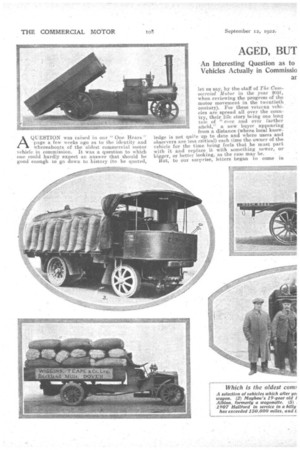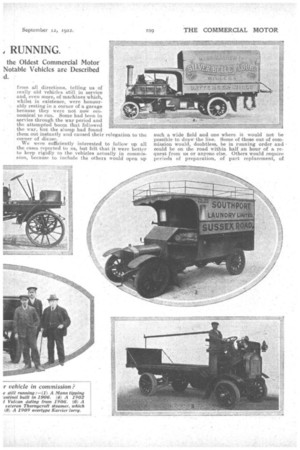AGED, BUT
Page 16

Page 17

Page 18

If you've noticed an error in this article please click here to report it so we can fix it.
, RUNNING.
• A QUESTION was raised in our " One Hears" page a few weeks ago as to the identity and whereabouts of the oldest commercial motor .vehicle in commission. It was a question to which one could hardly expect an answer that should be good enough to go down to history (to be quoted, let us say, by the staff of The Commercial Hotor in the year 2001, when reviewing the progress of the motor movement in the twentieth century). For these veteran vehicles are spread all over the country, their he story being one long tale of " ever and ever farther afield," a new buyer appearing from a distance (where local knowledge is not quite up to date and where users and observers are less erotical) each time the owner of the vehicle for the time being feels that he must part with it and rep-lace it with something newer, or bigger, or better looking, as the case may be.
But, to our surprise, letters began to come in from all directions, telling us of really old vehicles still in service and, even more of machines which, whilst in existence, were honourably resting in a corner of a garage because they were not now economical to run. Some had been in service through the war period and the attempted booni that followed the war, but the slump had found them out instantly and caused their relegation to the corner of disuse.
We were sufficiently interested to follow up all the cases reported to us, but felt that it were better to keep rigidly to the vehicles actually in commission, because to include the others would open up
such a wide field and one where it would not be possible to draw the line. Some of those out of commission would, doubtless, be in running order and • could be on the road within half an hour of a request from us or anyone else. Others would require periods of preparation, of part replacement, of
repair and even rebuilding. In fact, one could discover vehicles now in the yards of parts dealers— such as are to be found at Walham Green, Walworth and elsewhere—which would date hack to the last century. •
In consequence of the interest occasioned by our question, we now have a. substantial folder full of correspondence, and many people have taken the trouble to secure for us photographs of the actual vehicles. We reproduce a few of these photographs and hope that their -appearance may encourage owners of other vehicles concerning which -a claim to age and continuous service may be made to send
us photographs and details. So far, the difficulty seems to be the prevision of anything in the nature of a connected history of an old vehicle. In the early days it was not regarded as an important matter to keep a record, and, to-day, owing to changes of ownership and of employees With knowledge of the vehicles, the story cannot always be pieced together. However, whatever can be done in this respect will, we feel sure, be appreciated by other readers of this journal.
Twenty Years of Service.
From Mr. Hugh Ross, a joiner at Biggar, we learn that the Albion lorry (type A 2), which was made in 1902 and is illustrated in Fig. 4, came into his hands in 1911. It then had a wagonette body and tiller steering. Mr. Ross converted it into a platform lorry, with a seat mounted over the engine casing, and be has used it continuously ever since in carrying loads of from 8 to 10 ewt. It is capable of climbing any hill a-round Biggar—and that can fairly be described as a hilly district. The owner estimates its mileage at 150,000 at the least, and probably 180,000 is nearer the actual mark. It still does from 171,o 20 miles per gallon of fuel; and is in good order, being, as Mr. Ross puts it, a credit to its designers and an example of the good quality of material and workmanship which the makers put into their work.
Mr. Mark Mayhew was one of the pioneers o-f motoring and an early user of power-driven road vehicles. For millers' work the steam, wagon rapidly showed its superiority over horsed vehicles, and Mark Mayhew, Ltd_., make considerable use of Foclens. The 5-tonner known to them as No. 880 (shown in Fig. 2) was supplied to them in March, 1903, and to date has travelled altogether about 110,000 miles, for it covers between 120 and 130 miles per week and is only off the road one day a fortnight. It has stood up to its work extraordinarily well, and there has never been the need for any big replacements, just the necessary renewals of parts that wear sufficing to keep the wagon in good trim. Except that the wheels were converted to take rubber tyres, the vehicle to-day is as it left the works 19 years ago.
London's Veteran Steam Wagon.
The oldest Thornycroft which we have been able to trace is the steam tipping-wagon No. A 3397, supplied to the City of Westminster in 1899 and used in the cleansing work of the city until 1920, covering in the period about -150,000 miles. It was sold to the Shoreditch Borough Council and is still in use by them. Our photograph (Fig. 7) was taken whilst the vehicle bore the name of the City of Westminster. Some of the twin-cylinder Yuleans made from 1906 to 1909, developing 10 h.p.' are still running. We have traced one (illustrated in Fig. 5) to the ownership of the Southport Laundry, Ltd., of Southport. They acquired it in September, 1909, for a country round averaging 125 miles per week. On this it gave satisfactory service for nearly two years, and by then the business had increased. until it was necessary to employ a bigger vehicle. So, for the country round,
34 a 15.0 h.p. Vulcan was purchased, and the twocylindered vehicle was put on town service, which, actually, is more severe in some Ways, as, in more or less house-to-house work, the stops and restarts are very numerous. During the war, the regular drivers having joined the It.A.S.C., the two vans were driven by women and were equipped with temporary . stretcher holders, doing good service in moving wounded men, four at a time, from the Red Cross trains to the hospitals. Other vehicles have been added to the fleet, but the 10 h.p.. van has covered about 80,000 miles, and the 15.9 van about 90,000 miles, and both are giving excellent service.
We are receiving information of the existence of a number of early Sentinel steam wagons. We have got back as far as wagon No. 112 (makers' number). This, we believe, is in Durham, whilst No. 113 is at work in Glasgow. Nos. I 19, 120, 128, 129, 133, 134, 135. and 137, all 1906 or 1907 vehicles, are also running, and we hope to get some 'details of their service. No. 129 is in the employ of Clarkes, Ltd.,. of Burgbfield Mills, Burglifield, Berks., and we are able to give a photograph of it in Fig. 3. Nearly 16 years old, it is still going strong. Sentinel wagon No. 132, which is nearly 14 years old, ran into the Sentinel works 'a few weeks ago to get some spare parts for one of the old Wagcins of the fleet to which it belonged!
Fifteen Years Old and Good for Some Years More.
The Hallford 31-tonner illustrated in Fig. 6 was supplied to Wiggins, Teape and Co.; Ltd.-, Buckland Mills, Dover, in 1907, and is, therefore, 15 years old. It has been in regular and continuous service in the hilly district around Dover, and, according to the owners, is giving entire satisfaction. Recently some of the gears, the tappets and the steering gear have been replaced, and the vehicle is regarded as good for some years to come. The owners, have reeently asserted that they are not desirous o: selling it, as it is giving such excellent service. It will he noted that the frame has riveted to it a fishbellied pressing, •which was the forerunner of the well-known Hallford design of frame, the shape being embodied in the side frame pressings about 1908, and since generally adopted for heavy vehicles. In Fig. I we show a Mann steam wagon still in, service, but the ownership of which is being ascertained for us. It dates back to 1900, and it brings to mind the original design introduced by Mann's Patent Steam Cart and Wagon Co., Ltd., whereby the body was carried on•a pair of wheels 5 ins, wide by means of outer side brackets, the " light locomotive " (as it was then called) being also on wheels 6 ins. wide. The two sets of wheels were carried underneath the body, and gave the equivalent of 10-in. wheels. The state of the law brought about this development, which permitted a tare weight of 41, tons instead of the then standard weight of 3 tons.
We have traced three early Karriers, Nos. 114, 118 (each type A.60) and 124 (type A.40), and we are able to illustrate in Fig. 8, No, 114, 'supplied in August, 1999; to the Bingley Industrial Cooperative Society,. Ltd,, of BingIey. It has undergone the usual minor repairs, and works every day and all day hauling loads up to 3 toriS, the district into which it has to work never being considered. The mileage approximates, on the average, 300 per week, and from 60 tons to 100 tons of produce is moved each week by its • The position of the driver will be noted, the Rarrier Coriapany being early exponents.of this method of increasing body space. The vehicle is doing excellent service, and the traffic manager of the company speaks highly of it an& of the usefulness of the winding gear, which enables the driver to deliver goods at the top of two or three-storied buildings,






























